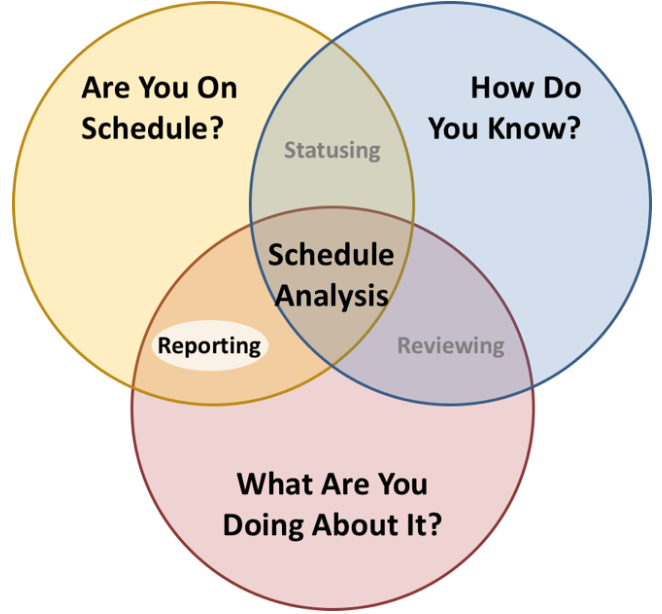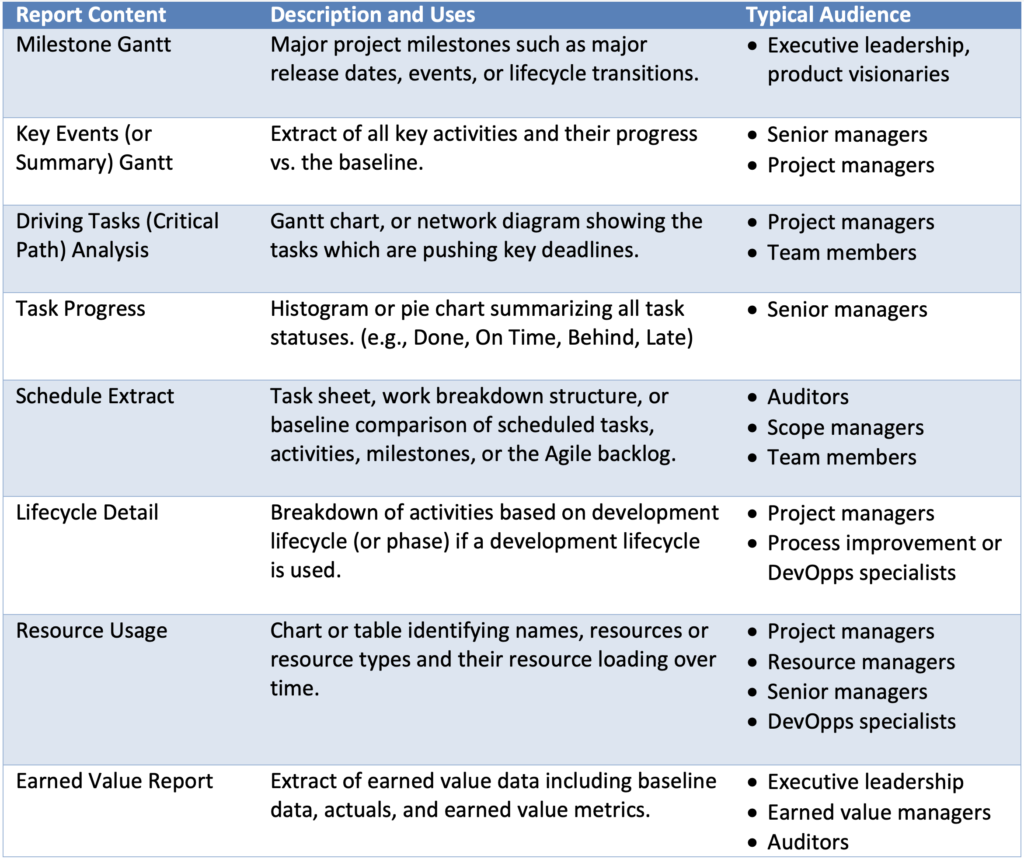
When project teams need to make a critical decision, it helps if the decision is an informed one. Most schedule stakeholders only look at schedule reports, never the actual schedule file. This makes reports indispensable for informing and justifying project decisions. Schedule reports also document a project’s progress over time. These historical trends aid managers in seeing what lessons should be learned and how to adjust their planning for the next project.
This article introduces some of the common schedule status reports, their audience, and the basic tenants to follow when reporting on the project schedule.
The Need to Know
Standards compliant project schedules contain a wealth of data about the projects they model. At a minimum, each Task in a resource loaded, baselined schedule file contains seventeen variables – not including custom fields, timescale data1Timescale data is a breakdown of the number of hours a Resource is assigned to a Task for a given day, week or month., and quasi-dependent variables such as percent complete2The typical formula for calculating Percent Complete is Actual Duration ÷ Projected Duration (i.e., Actual + Remaining). Actual and Remaining Duration are two of the seventeen variables listed above.. Like a sports reporter covering a baseball season, the large supply of data produces volumes of metrics. Which statistics are noise? What can be converted into useful, actionable knowledge?
Producing decision quality information requires the Schedule Manager to understand what stakeholders need to do with the information they have. A good schedule status report will tell its audience exactly what they need to know and avoid burdening them with data which is spurious or distracting. Figure 37 summarizes some common schedule status reports and their use.

It is common for stakeholders to want to see more schedule intel than simply the elements which are directly tied to their role on the project. Team members want to see the milestone Gantt’s big picture. Senior leadership may want to understand portions of the critical path or other operational metrics. Auditors want to see everything. Sharing extra information is rarely detrimental to the project. The only time schedule reports should not be shared is when the report contains sensitive information. This is one of the reasons why a schedule file should not be burdened with sensitive content such as project finances.
When sharing reports with new audiences, ensure that reports come with proper context to guard against unnecessary panic. For example, suppose a project’s Schedule Performance Index (SPI) is 0.833SPI is the financial value of work performed to date over the value of the work planned to date. (SPI = EV ÷ PV) An SPI of 0.9 indicates that 10 percent of the work planned to date is behind schedule. An SPI between 0.85 and 0.9 commonly triggers executive leadership to take corrective action., and Senior Executives request an extract of all project tasks which are running late. Without context, this report becomes a list of accusations against some luckless team. The Schedule Manager must also provide context regarding which delayed tasks are consequential to the project at large. Despite the low SPI, the project may be running smoothly, and the key project deadlines may not be impacted. The Schedule Manager must be able to distinguish to all stakeholders the difference between trivial delays and delays that matter.
Consistency and Simplicity
It is important to remember that schedule status reports are a means to an end. Reports should convey knowledge quickly and succinctly. Regardless of content, high-quality schedule reports share the following characteristics:
- Accuracy – The report accurately reflects data in the schedule, which in turn reflects reality and stakeholder consensus.
- Consistency – The report conveys information in the same format every reporting cycle.
- Easy to Understand – The report’s audience can clearly comprehend its contents.
- Easy to Produce – The report can be produced with minimal effort and data manipulation.
These characteristics provide reliability to both the schedule and the Schedule Management process so that the reader can comprehend, then act on the schedule report as quickly as possible.
Next Steps
Regular project schedule reporting is as essential to the project as the schedule itself. If reports do not convey accurate information about the progress and likely completion of the project, then both the schedule and the reports provide no tangible value to the project. Starting with some basic assumptions about the fitness of the project schedule, Schedule Reporting Principles makes the case for ensuring that schedule reports are traceable directly to the schedule itself, and for providing full transparency and context to all project stakeholders.
Related Case Study: Why Do You Need to Know
